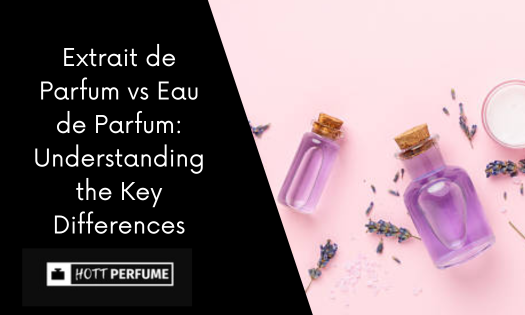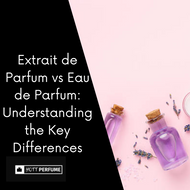Extrait de Parfum vs Eau de Parfum: The Key Differences
Posted by Tina Wilson on Sep 16th 2025

Introduction to Perfume Concentrations
Perfume concentrations refer to the amount of fragrance oils dissolved in alcohol and water, which directly impacts the scent’s intensity, longevity, and overall experience. Common types include eau de parfum, eau de toilette, extrait de parfum, and eau de cologne, each offering a different balance of fragrance strength and wearability. Knowing these differences helps you choose the perfect perfume for various occasions—whether you want a subtle everyday scent or a powerful, long-lasting fragrance for special events.
Eau de parfum is popular for its well-rounded, enduring aroma, while extrait de parfum is prized for its richness and depth, often considered the most luxurious form of perfume. Understanding the concentration levels, especially the differences in extrait de parfum vs eau de parfum, allows you to make informed decisions about which fragrance suits your style and needs best.
Key points to understand about perfume concentrations:
-
Fragrance Oil Concentration: Determines the strength and longevity of the scent; higher oil content means a more intense and longer-lasting fragrance.
-
Eau de Parfum (EDP): Typically contains 15-20% fragrance oils, offering a balanced scent that lasts several hours, suitable for daily wear.
-
Extrait de Parfum: Contains 20-40% fragrance oils, providing a richer, more concentrated scent with exceptional staying power, ideal for special occasions.
-
Eau de Toilette (EDT): Has a lower concentration (5-15%), resulting in a lighter, more subtle fragrance that may require reapplication throughout the day.
-
Eau de Cologne: The lightest concentration (2-5%), offering a fresh and fleeting scent, often used for quick refreshment.
-
Choosing the Right Concentration: Depends on personal preference, occasion, climate, and how long you want the fragrance to last.
By understanding these factors, you can select a perfume concentration that perfectly matches your lifestyle and fragrance preferences.
What Tom Ford Cologne Smells the Best? Top Picks for 2024
Characteristics of Eau de Parfum
Eau de parfum (EDP) is a popular fragrance concentration known for its balance of intensity and longevity, making it the perfect choice for a wide range of occasions; eau de parfum edp is particularly favored for its lasting quality.
-
Contains 15-20% fragrance oil concentration, providing a noticeable yet not overpowering scent.
-
Typically lasts between 4 to 6 hours, offering reliable longevity throughout the day.
-
Ideal for those who prefer a lighter scent profile without compromising on lasting power.
-
Perfect for casual outings, work environments, and everyday activities, delivering a refreshing and versatile aroma.
-
Eau de parfum is favored by many perfume enthusiasts for its balanced intensity and adaptability to different settings.
This concentration strikes a harmonious balance between strength and subtlety, making it a versatile choice for daily wear or a light and refreshing scent .
Extrait de Parfum Overview
Extrait de parfum is the most concentrated and luxurious form of perfume, offering an intense and long-lasting fragrance experience.
-
Contains the highest fragrance oil concentration, typically between 20% and 40%.
-
Provides a rich, bold, and intense scent, perfect for special occasions and evening wear.
-
Offers exceptional longevity, with the fragrance lasting 8 hours or more on the skin.
-
Generally more expensive than other perfume types due to its concentration and quality.
-
Designed to make a lasting impression with a deep, captivating aroma that stands out.
Extrait de parfum is an excellent choice for those seeking a powerful and enduring fragrance that exudes luxury and sophistication.
Comparison of Perfume Types
Understanding the differences between perfume types helps you select the fragrance that best suits your lifestyle and preferences.
-
Eau de Toilette (EDT): Contains 5-15% fragrance oil, offering a lighter, more refreshing scent that lasts for a shorter duration.
-
Eau de Cologne: Has an even lower concentration of 3-5%, known for its invigorating and refreshing qualities, often used for quick refreshment.
-
Extrait de Parfum: The most concentrated type, with 20-40% fragrance oil, providing an intense, rich, and long-lasting scent ideal for those who prefer a bold and luxurious fragrance.
-
Choosing the right concentration depends on how strong and long-lasting you want your scent to be, as well as the occasion and personal taste.
-
Concentrated fragrances like extrait de parfum are perfect for making a lasting statement with a powerful aroma.
By knowing these distinctions, you can confidently pick a perfume that complements your daily routine and special moments.
Fragrance Oils and Composition
Fragrance oils form the core of any perfume, defining its scent and character.
-
The composition includes top notes, heart (middle) notes, and base notes, each contributing to the scent’s evolution and longevity.
-
High-quality fragrance oils are vital for creating a rich, complex aroma that lasts on the skin.
-
The concentration of these oils determines the perfume’s intensity and staying power; higher concentrations yield stronger, longer-lasting scents.
-
Perfume oils are essential to the overall fragrance experience, and their quality significantly impacts how the scent performs and is perceived. For more about how these qualities are evaluated by real customers, see independent HottPerfume.com reviews.
Understanding fragrance oils and their composition helps in appreciating the artistry behind every perfume and choosing one that suits your preferences.
Key Features to Consider
When selecting a perfume, several important factors can help ensure you find the perfect scent for your preferences and lifestyle.
-
Fragrance Concentration: Determines the intensity and longevity of the scent, with options ranging from lighter eau de toilette to more concentrated extrait de parfum.
-
Longevity: Consider how long you want the fragrance to last, especially for different occasions or daily wear.
-
Scent Profile: Choose a fragrance that matches your personal taste, whether floral, woody, fresh, or oriental.
-
Application Points: Apply perfume to pulse points like wrists and neck, where body heat helps the scent develop and linger.
-
Season and Occasion: Lighter, fresher scents are ideal for warmer weather, while richer, more intense fragrances suit cooler seasons and evening events.
-
Understanding Terminology: Familiarity with terms like eau de parfum and extrait de parfum aids in making informed fragrance choices.
By considering these key features, you can select a perfume that complements your style and meets your needs perfectly.
Perfume Longevity and Seasonality
Perfume longevity refers to the duration a scent remains noticeable on the skin, influenced by factors such as fragrance concentration and individual skin type. Seasonality also plays a significant role in fragrance selection; lighter, fresher scents are typically preferred during warmer months, while richer, deeper fragrances are better suited for cooler weather. For evening events and special occasions, more intense and long-lasting perfumes, such as those with amber, are ideal, whereas daily wear often calls for lighter, more refreshing aromas. Understanding how longevity and seasonality affect fragrance choice helps individuals pick the perfect scent for any time or event. Ultimately, perfume longevity is a key factor in creating a lasting impression and overall satisfaction with a fragrance.
Cologne vs Body Spray: Which Should You Choose?
Understanding Perfume Terminology
Perfume terminology includes terms like eau de parfum, extrait de parfum, and eau de toilette, which describe specific fragrance concentrations and characteristics. Understanding these terms is crucial for navigating the world of perfumery and making informed choices when selecting a fragrance. While the terminology can seem complex, grasping the basics allows individuals to better communicate their preferences and find the perfect scent.
Familiarity with these terms is essential for anyone interested in exploring fragrances, as it helps in comparing products and understanding their intensity, longevity, and suitability. Knowing the differences between parfum, eau de parfum, and extrait de parfum empowers buyers to make confident and satisfying perfume purchases.
Making an Informed Decision
Selecting the right perfume requires careful consideration of several key factors to find a scent that truly suits you. If you’re interested in classic options like Armani Code and Acqua di Gio, for tips on how to score the best deals when buying the right perfume, such as Armani Sport Code, check out our guide.
-
Consider fragrance concentration, scent profile, and longevity to match your preferences and lifestyle.
-
Test perfumes on your skin and allow the scent to unfold to see how it interacts with your body chemistry.
-
Understand perfume terminology and concentration levels to make knowledgeable choices for various occasions.
-
Choose a fragrance that elevates your mood and confidence, reflecting your personal style.
-
Taking time to evaluate these factors ensures a satisfying and lasting fragrance experience.
Being informed helps you select a perfume that complements you perfectly and enhances your presence.
Conclusion
Extrait de parfum and eau de parfum are two distinct perfume concentrations, each showcasing their luxurious nature and offering unique characteristics and benefits. Understanding the differences, particularly the main difference between eau de parfum and other types, empowers individuals to select fragrances that best fit their lifestyle and personal preferences. By considering key factors such as fragrance concentration, scent profile, and longevity, you can make informed choices and find the perfect perfume to meet your needs. Whether you prefer a light, refreshing aroma or a rich, intense scent, there is a concentration suited to every taste. Ultimately, choosing the right perfume involves thoughtful consideration to ensure a satisfying and lasting fragrance experience.


